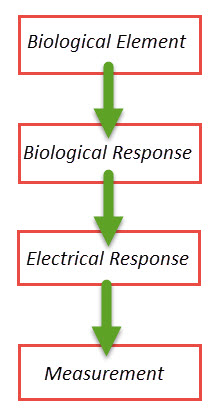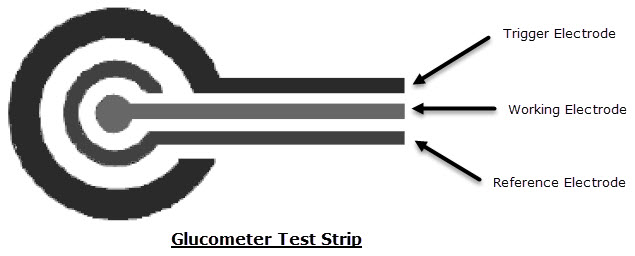Introduction
Before diving into the details of Biosensors, let us quickly recap the concept of sensors in general. Sensor is a device which detects changes in a physical quantity like temperature, humidity, water flow, intensity of light etc. and converts it into a quantity that can be measured and/or analyzed. If this definition seems a little bit confusing, then let us try to understand it with the help of a simple example. We all know LDR or Light Dependent Resistor. It is a simple device whose resistance changes according to the ambient light intensity. Usually, when the intensity of the light is more, its resistance is very low and if the intensity is high, well, its resistance shoots up to a very high value. This means that a simple device like LDR can act as a Light Sensor as it produces a quantity (its resistance) corresponding to the quantity it is measuring (light). Similarly, a Biosensor is a device, which converts a Biological signal into a more useful electrical signal. We will see more about the “Biological signal” as we move along with the tutorial.
What are Biosensors?
The simplest definition of a Biosensor is given here: A Biosensor is an analytical device that detects changes in Biological processes and converts them into an electrical signal. The term Biological process can be any biological element or material like enzymes, tissues, microorganisms, cells, acids, etc. So, a Biosensor is a combination of a Biological sensing element and a transducer, which converts the data into electrical signals. Additionally, there will be an electronic circuit which consists of a Signal Conditioning Unit, a Processor or Microcontroller and a Display Unit. The following is a simplified block diagram showing the important components of a Biosensor.
In the above block diagram, the Signal Conditioning unit comprises of an Amplifier and a Filter (usually a Low Pass Filter) circuitry. This block diagram will be clearer when we take a look at an example in the coming sections.
Principle of a Biosensor
The desired biological material is usually in the form of an enzyme. By a process known as Electroenzymatic approach, which is a chemical process of converting the enzymes into corresponding electrical signals (usually current) with the help of a transducer. One of the commonly used Biological response is the oxidation of the enzyme. Oxidation acts as a catalyst and alters the pH of the biological material. The change in pH will directly affect the current carrying capacity of the enzyme, which is once again, in direct relation to the enzyme being measured.
Output of the transducer i.e. the current, is a direct representation of the enzyme being measured. The current is generally converted into voltage so that it can be properly analyzed and represented.
Working of Biosensors
The combination of biological sensitive element and a transducer will convert the biological material into a corresponding electrical signal. Depending on the type of enzyme, the output of the transducer will be either current or voltage. If the output is voltage, then well and good. But if the output is current, then this current should be converted into equivalent voltage (using an Op-Amp based current to voltage converter) before proceeding further. The output voltage signal is usually very low in amplitude and superimposed on a high frequency noise signal. So, the signal is amplified (using an Op-Amp based Amplifier) and then passed through a Low Pass RC Filter. This process of amplifying and filtering the signal is the job of a Signal Processing Unit or a Signal Conditioning Unit. The output of the signal processing unit is an analog signal that is equivalent to the biological quantity being measured. The analog signal can be displayed directly on an LCD display but usually, this analog signal is passed to a Microcontroller, where the analog signal is converted into digital signal, since it is easy to analyze, process or store a digital signal.
Example of Biosensor
Before proceeding further with different types of Biosensors and applications of Biosensor, let us quickly take a look at a simple example of a Biosensor: The Glucometer, which is one of the most common applications (unfortunately). Diabetes is a disease characterized by the levels of glucose in the blood. Regularly checking the blood glucose levels is very important for diabetes patients. Glucometers are a type Biosensors, which measure the concentration of glucose in blood. Usually, they consists of a test strip, which collect a small sample of blood to analyze the glucose levels. This particular sensor implements the Electroenzymatic approach i.e. oxidation of glucose.
The test strip consists of a trigger electrode and a reference electrode. When blood is placed on the test strip, a simple chemical reaction takes place and an electrical current is generated, which is directly proportional to the concentration of glucose. Internally, the Glucometer consists of a powerful processor like a Cortex-M3 or Cortex-M4 along with current to voltage converter, amplifier, filter and a display unit.
Different Types of Biosensors
Biosensors are classified into two groups i.e. either based on the Biological Element used in the analysis or the method of transduction implemented. As mentioned already, some of the commonly used biological elements or bio-recognition elements are DNA, enzymes, antibodies, microorganisms, tissues, cell receptors etc. The next and most commonly used classification of Biosensors is based on the type of transduction used in the sensor i.e. type of physiochemical resulting from the sensing event. Further, the biosensors based on method of transduction are again divided into three types. They are:
Mass based Biosensors Optical based Biosensors Electrochemical Biosensors
There are again few subclasses in each of these types. The following image shows a comprehensive list of different types of Biosensors.
Piezoelectric Biosensors
They are a subdivision of Mass based Biosensors. Piezoelectric Biosensors are also known as Acoustic Biosensors as they are based on the principle of sound vibrations i.e. acoustics. When a mechanical force is applied on a piezoelectric biosensor, they produce an electrical signal. The biological elements are attached to the surface of the piezoelectric biosensor. The piezoelectric biosensor, which is essentially a mass to frequency converter, converts the mechanical vibrations of the sensing molecules into proportional electrical signals.
Electrochemical Biosensors
In electrochemical biosensors, the biological molecules are coated onto a probing surface. The sensing molecules are held in place with the help of non-interfering membrane. Then, the sensing molecules react appropriately to the compound to be detected and produces an electrical signal proportional to the quantity being measured. Electrochemical Biosensors can employ various types of transducers like Potentiometric, Amperometric, Impedimetric etc. converting the chemical information into a measurable electrical signal.
Optical Biosensors
Optical Fibers play an important role in Optical Biosensors. The optical fibers allow detection of the sensing elements based on the different properties of light like absorption, scattering and fluorescence. The reaction causes changes in either of the above mentioned properties as a result of the change in the refractive index of the interacting surface. For example, if the biological elements are antibodies and are bound with a metal layer, the refractive index of the medium which comes in contact with this layer will be varied. One of the main advantages of using optical biosensors is their non-electrical nature. This allows them to analyze multiple elements on a single layer just by varying the wavelength of the light.
Applications of Biosensors
Since their development in the early 1950’s, Biosensors have become very important in the fields of medicine, clinical analysis and in general health monitoring. The advantages of biosensors over lab based equipment are as follows:
Small size Low cost Quick results Very easy to use
Apart from the desired medicine and health based applications, Biosensors have also found critical applications in several other fields like industrial processing, agriculture, food processing, pollution control etc. So, the following is a small list of the potential fields where Biosensors are frequently used.
Medicine, Clinical and Diagnostic Applications Environmental Monitoring Industrial Applications Food Industry Agriculture Industry
Let us briefly take a look at these areas of application of Biosensors individually.
Medicine, Clinical and Diagnostic Applications
The main area of interest of Biosensor is the Medicine, Clinical and Diagnostics applications. Electrochemical based Biosensors are commonly used in biochemical labs and clinics to monitor and measure glucose levels as well as lactic acid. Commercial Biosensor in the field of personal health care are becoming quite popular, especially, self-monitoring of blood glucose. The main advantage of this method is the blood samples cannot be contaminated and also it is undiluted for more accurate results. Earlier self-monitoring devices are one-time use applications i.e. test can be performed for a single time and the sensor must be disposed after that. But advances in this field allows, reusable sensors for improved patient care.
Environmental Monitoring
One of the major application of Biosensor is in the field of Environmental Pollution Monitoring. Especially, water pollution monitoring is an area where Biosensors have substantial advantage. There are numbering pollutants that are contaminating ground water and as a result the quality drinking water is getting worse. Biosensors with sensing elements for nitrates and phosphates are becoming common for battling water pollutants. Another important application is for the military to detect chemicals and hazardous biological specimens that can be used a bio-weapons.
Industrial Applications
Fermentation is a large industrial operation used in dairy, alcohol and other similar products. Large scale Bacteria and cell culture must be maintained for this purpose. In order to minimize the cost of production and risk free fermentation, it is essential to monitor these delicate yet expensive processes. Biosensors are designed to monitor and measure the generation of a fermented product.
Food Industry
Commercial Biosensors that can measure carbohydrates, acids, alcohol, etc. are already available in the market. Biosensors are used in food industry for food quality control for measurement of amino acids, carbohydrates, alcohols, gases, etc. Some of the common food industries are Wine, Beer, Yogurt, soft drinks etc.
Agriculture Industry
Biosensors in the field of agriculture are generally used for detection of pesticides. Comment * Name * Email * Website
Δ









![]()